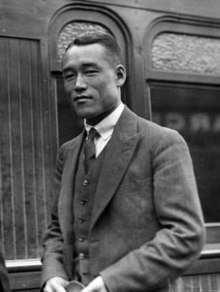Our website is made possible by displaying online advertisements to our visitors.
Please consider supporting us by disabling your ad blocker.
Jiro Sato
 Jiro Sato in 1932 at Central Station, Sydney | |
| Country (sports) | |
|---|---|
| Born | January 5, 1908 Gunma Prefecture, Empire of Japan |
| Died | April 5, 1934 (aged 26) Strait of Malacca |
| Turned pro | 1929 (amateur tour)[1] |
| Retired | 1934 (death) |
| Plays | Right-handed |
| Singles | |
| Career record | 128-26 (83.1%) [2] |
| Career titles | 18 [2] |
| Highest ranking | No. 3 (1933, A. Wallis Myers)[3] |
| Grand Slam singles results | |
| Australian Open | SF (1932) |
| French Open | SF (1931, 1933) |
| Wimbledon | SF (1932, 1933) |
| US Open | 4R (1933) |
| Doubles | |
| Grand Slam doubles results | |
| Wimbledon | F (1933)[4] |
| Mixed doubles | |
| Grand Slam mixed doubles results | |
| Australian Open | F (1932)[5] |
Jiro Sato (佐藤 次郎, Satō Jirō, Japanese pronunciation: [sa.toː dʑi.ɾoː]; January 5, 1908 – April 5, 1934) was a Japanese tennis player. He was ranked world No. 3 in 1933, but committed suicide in the Strait of Malacca during his trip to the Davis Cup in 1934.[6]
He received worldwide fame in Wimbledon 1932, when he beat the defending champion Sidney Wood at the quarterfinal. In the semifinal, he lost to Bunny Austin. His peak came in 1933, when he beat Fred Perry in the French Open quarterfinal. He was ranked world No. 3 by A. Wallis Myers of The Daily Telegraph, behind Jack Crawford and Fred Perry.[7] However, it got more and more difficult for him to endure the enormous pressure from Japan. It is believed that pressure drove him to throw himself overboard into the Strait of Malacca on April 5, 1934, at 26 years of age.[6]
- ^ Cite error: The named reference
tennis&golf5was invoked but never defined (see the help page). - ^ a b Garcia, Gabriel. "Jiro Sato: Career match record". thetennisbase.com. Tennismem SL. Archived from the original on 5 August 2022. Retrieved 7 November 2017.
- ^ Andy Yanne (December 3, 2006). "Asian players who made a mark: A historical look". tennishk.org. Hong Kong, China: Hong Kong Tennis Association. Archived from the original on April 15, 2013. Retrieved October 23, 2012.
- ^ Cite error: The named reference
Straitswas invoked but never defined (see the help page). - ^ "1932 Mixed Doubles". australianopen.com. Melbourne: Tennis Australia. Archived from the original on January 17, 2013. Retrieved October 23, 2012.
- ^ a b John Cottrell (August 30, 1971). "Death En Route To Wimbledon". Sports Illustrated. Vol. 35, no. 9. Sydney, Australia. Archived from the original on December 3, 2013. Retrieved October 23, 2012.
- ^ "Mr. Wallis Myers' ranking". The Sydney Morning Herald. 103 (29, 866). Sydney: 7. September 22, 1933. Retrieved March 15, 2013.
Previous Page Next Page


